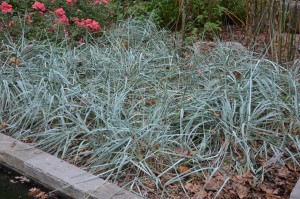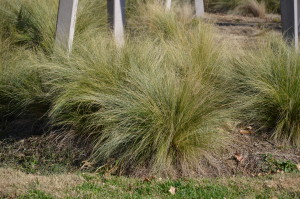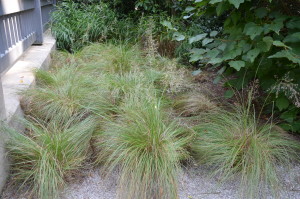These three native grasses are easy to establish in average, dry to medium moist, well-drained soils and in full sun. They tolerate a wide range of soils including dry rocky sites, and are exceptionally drought tolerant. Figure on 1 to 2 years for each to become fully established.
Blue Lyme Grass (Leymus arenarus ‘Blue Dune’) is a vigorous spreading cool season grass, 24-30 inches tall, with steel blue foliage and arching growth habit. Blue Lyme is a vigorous grower in warm areas of the U.S. (USDA Hardiness zones 4-10).
Tall flower spikes appear in mid-summer. It grows in a wide range of soils, wet to dry, and in either full sun to partial shade. It grows less aggressive in dry, clay soils. Foliage remains evergreen in zone 8-10; otherwise, blades take on a beige tint in early fall.
Prairie dropseed (Sporobolus heterolepsis) is a clump-forming, warm season, perennial grass found in prairies, glades, and open land areas native to the Midwest U.S. (USDA hardiness zones 3-9). Light airy inflorescences (flower panicles) rise several inches above the fine textured, deep green foliage in September and October.
Prairie dropseed forms mounds of arching foliage, each 1 ½ feet tall and 3 feet wide. Leaf blades turn a golden fall color with orange hues and later to light bronze over winter. Flower panicles have pink and brown tints, and emits a hint of coriander or popcorn fragrance. Tiny rounded mature seeds drop to the ground from their hulls in autumn and serve up a morsel for seed feeding birds. It generally does not self-seed in the garden.
Mexican feather grass or silky thread grass (Naasella tenuissima) is a light airy ornamental grass that flutters in the slightest of breezes (USDA hardiness zones 5-10). Plant in groups of 5 or more to create waves of fine foliage. In the first year irrigate over the first 2-3 months until established and is highly drought tolerant from this point on.
Their green silky inflorescences will soften landscape areas from late spring into late summer, the plumes swaying in the slightest breeze. Plumes turn brown in late summer. Remove winter dead growth at the start of spring.




 Posted in
Posted in 
